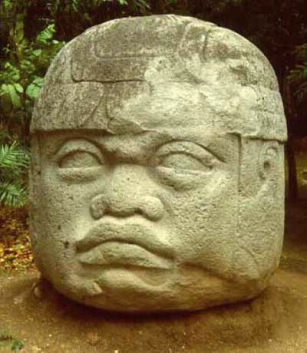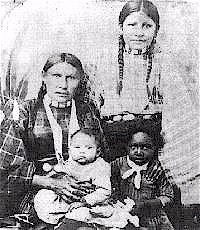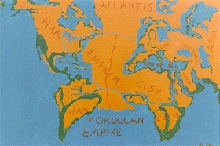Federation : MSTA
The Moorish-Algonquin-Iroquois
Federal Government

There has been reference to the Moors as a force in North America
prior to the 1600’s. MacRitchie in “Ancient and Modern Britons”
wrote about the Moors that fought the Christians and New England
in 1676. An article describing the even used the terms Moor and
Indian interchangeably.
And the presence of the Delaware Moors, also called Nanticote
and Lenni Lenape has also been well documented. Some of the Delawares
acknowledge a Moorish (Moroccan) origin for their tribe.
According to historians, the Indians (Moors) of the northeast
corridor of America were perennially aat war with one another
until, as the Iroquois tradition states, Deganawida, a Huron from
what is now eastern Ontario, proposed the creation of a league
of five Indian nations. He found a spokesperson, Hiawatha, to
undertake the arduous task of negotiating with the warring Indian
nations. Hiawatha succeeded in accomplishing Deganawidah’s dream,
and the Senecas, Onondagas, Oneidas, Mohawks, and Cayugas ceased
their struggle and formed a federal union.
There is some disagreement about when the league began. There
is a good scholarly case to substantiate the traditional oral
accounts suggesting the 1100s as the founding of the Haudenosaunee
Confederacy (the Iroquois called themselves Haudenosaunee, meaning
“people of the longhouse”).
Another nation, the Tuscaroras, moved northward from the Carolinas,
joining the league around 1714.
The so-called savages of the New World had formed a federation
that would be the envy of Franklin, Jefferson, and Washington.
The Iroquoian system, expressed through its constitution, “The
Great Law of Peace,” rested on assumptions foreign to monarchies
of Europe: it regarded leaders as servants of the people, rather
than their masters, and made provisions for the leaders’ impeachment
for errant behavior. The Iroquois’ law and custom upheld freedom
of expression in political and religious matters, and it forbade
the unauthorized entry of homes. It provided for political participation
by women and the relatively equitable distribution of wealth.
The Iroquois prized individual independence, and their government
was set up so as to preserve that independence. The Iroquois confederation
contained the “germ of modern parliament, congress and legislature.”
The symbol of the Iroquois league’s Great Law of Peace was the
Great Tree of Peace. When Deganwidah stood before the first council
of the United Nations at Onondaga and planted the Tree of the
Great Peace, he planted in the hearts of his people a symbol that
was to give power and permanence to their union.
The Iroquois excelled at the management of human relationships.
To them, peace was the law. Peace was righteousness in action
and the great good. They used the white pine tree as their symbol
for peace and likened its roots stretching to all corners of the
earth to the extension of peace and law to all humankind. The
branches symbolized shelter, security, and protection provided
by the law of peace. If the law of peace was the constitution
of the union of the tribes, then the tree was the living symbol
of their constitution.
The eagle atop the tree symbolized watchfulness and a need to
be ever vigilant and farseeing, and to stand guard to defend liberty,
the peace, the union, and the constitution. The war club beneath
the tree symbolized the burial of weapons of war because hostilities
between the nations ended in union. Contrast the burial of weapons
with the eagle on the one dollar bill with olive branch in one
talon and 13 arrows in the other.
Centuries before Columbus arrived in the New World, democracy
was alive and well, just waiting for the “Founding Fathers” to
discover it. The American Indians (Moors) established a democratic
government of their own before the time of the white man, which
is a term that didn’t apply to the European until he successfully
invaded America. Early settlers – and later Americans – owed their
very existence to the Indians (Moors). As Felix Cohen asserted,
“The real epic of America is the yet unfinished story of the Americanization
of the white man.”
Benjamin Franklin became aware of the accomplishments of the Iroquois
League and spread the word through his work as a printer. He published
booklets detailing the proceedings of Indian treaty councils as
early as 1736. One such council was held in 1744 in Lancaster,
PA, where representatives from Maryland, Virginia, and Pennsylvania
met with the chiefs of the Iroquois League and agreed to an Anglo-Iroquois
alliance. Both sides needed this alliance to halt France’s determination
to dominate the New World. The colonies agreed to control the
recurrent problem of Scotch-Irish frontiersmen who were squatting
on Indian land without permission, and in return the Indians (Moors)
would side with the English against France.
In the course of this meeting on July 4, 1744, the Indian spokesperson,
Canassatego, much revered by both Indians and colonists, advised
that the colonies unite, just as the Indians (Moors) had done
centuries before. “Our wise forefathers established Union and
Amity between the Five Nations. This has made us formidable; this
has given us great Weight and Authority with our neighboring Nations.
We are a powerful Confederacy; and by your observing the same
methods, our wise forefathers have taken, you will acquire such
Strength and power. Therefore, whatever befalls you, never fall
out with one another,” he said.
In 1751 Franklin thought that the colonists should accept the
Iroquois advice to form a union in common defense under a common,
federal government…. “It would be a very strange thing if Six
Nations of Ignorant Savages should be capable of forming a Scheme
for such an Union and be able to execute it in such a manner,
as that it has subsisted Ages, and appears indissoluble, and yet
a like union should be impracticable for ten or a dozen English
Colonies.”
Franklin served as one of the colony’s commissioners at a meeting
in 1753 with the six nations in Carlisle, PA. The Carlisle Treaty,
which supported national defense against the French, began Franklin’s
diplomatic career. In 1754 the Albany Congress convened to cement
the alliance with the Iroquois and to formulate and ratify a plan
of uniting the colonies, as Canasstego had proposed ten years
earlier.
The similarities are obvious between the Albany plan of union
created by Franklin and the League of the Iroquois Nations. Franklin
proposed that a president-general appointed by the crown preside
over the colonies. Each state would retain its internal sovereignty
and constitution so that distrust among states due to wide diversity
of opinions and geographical separation could be somewhat neutralized.
The Iroquois resolved this difficulty by requiring that all “states”
agree on a particular action before putting it into effect. Another
similarity was that Franklin’s proposed Grand Council and the
Iroquois Great Council were both unicameral, unlike the British
bicameral system.
Franklin’s leadership in proposing the Albany Plan made him the
progenitor of the colonial union and a federalist system of government.
He was too far ahead of his time, though, and the Albany Plan
died in the state legislatures, which pleased the British. It
was to resurface two decades later, after the Stamp Act united
the colonies, and eventually would result in the Articles of Confederation.
However, Prophet Noble Drew Ali taught the Moorish Americans,
part descendants of these indigenous Moors, that the free national
constitution was ratified in 1774. Noble Drew Ali stated that
“the free national constitutional law that was enforced since
1774 declared all men equal and free and that constitution has
never been changed.”
Starting in October 1775, the flag flown from the American fleet
to intercept British supplies coming to Boston had a design that
was inspired by the Iroquois League’s Great Tree of Peace. It
shows a white ground with a green pine tree and the motto “An
Appeal to Heaven.” Also in 1775, a delegation from the colonies
met in hopes of negotiating an alliance against the British with
chiefs of the Six Nations at Philadelphia. The commissioners repeated
almost word for word the speech of Canassatego:
“Brothers, our forefathers rejoiced to hear Canassatego speak…[His
words] sunk deep into our hearts. The advice was good. It was
kind. They said to one another: “The Six Nations are a wise people,
let us hearken to them, and take their counsel; and teach our
children to follow it.” Our old men have done so. They have frequently
taken a single arrow and said, Children, see who easily it is
broken. Then they have taken and tied twelve arrows together with
a strong string or cord and our strongest men could not break
them. See, said they, this is what the Six Nations mean. Divided,
a single man may destroy you; united, you are a match for the
whole world. We thank the great God that we are all united; that
we have a strong confederacy, composed of twelve provinces… These
provinces have lighted a great council fire at Philadelphia and
sent sixty-five counselors to speak and act in the name of the
whole, and to consult for the common good of the people…”


